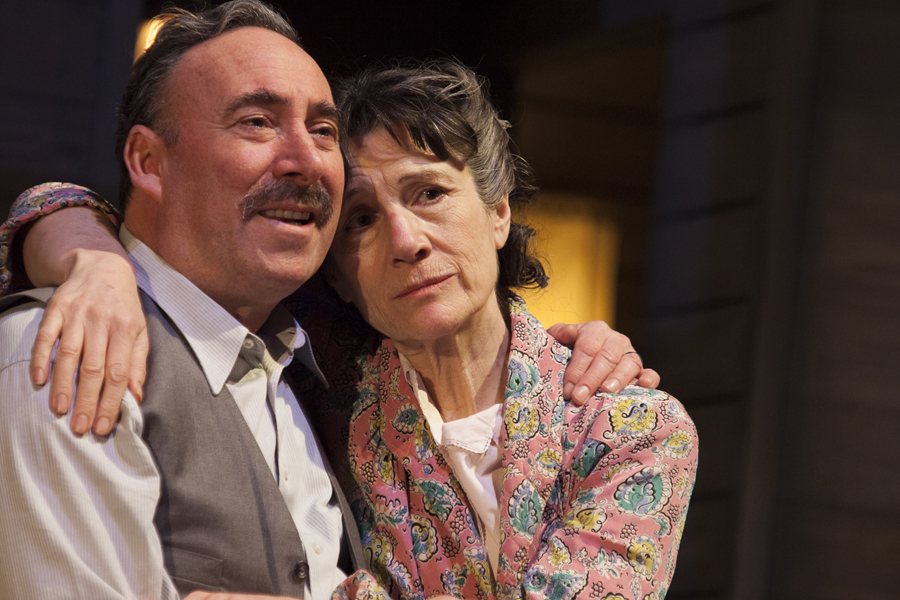 Director Gregory Doran is in no doubt that Arthur Miller's Death of a Salesman is the greatest American play of the 20th Century, addressing not only the heartbreaking conflicts within a family, but also bigger issues of national values and uncritical acceptance of the American Dream.
Director Gregory Doran is in no doubt that Arthur Miller's Death of a Salesman is the greatest American play of the 20th Century, addressing not only the heartbreaking conflicts within a family, but also bigger issues of national values and uncritical acceptance of the American Dream.
After a life of honest toil, Willy wants to stop travelling, pay off the mortgage and bask in the success of his two sons. But he can’t come to terms with the fact that his life and the lives of his boys are so different from his dreams of wealth and triumph. Miller explores the tragedy of what happens to a man who does not have a grip on the forces of life, as he puts it, whose career is disintegrating and the toll this takes on relationships between family members.
Miller was the son of Austrian-Jewish immigrants. His father worked his way up in New York's Lower East Side garment industry to become a wealthy man. The family lived in Manhattan until they lost it all in the depression and withdrew across the bridge to Brooklyn. As a teenager Miller worked to help supplement the family income with a bread delivery round before school. And he saw at first hand men like his salesman uncle Manny who sold not so much their product as their personality. Indeed, Miller is careful not to reveal what products Willy sells, leaving each audience member to furnish their own and make a closer connection to this everyman left battered and broken by capitalism.
Part of the challenge of the play comes from Miller’s extensive use of what he calls the continuous present – not quite flashbacks but simultaneous layers of memory. This means the actors have to shift almost instantaneously into playing a range of different ages and psychological states, and the production too must find ways of mirroring the layers.
Antony Sher is outstanding as the weary, manic-depressive Willy, from his iconic entrance – “tired to the death” – lugging his two heavy sample cases, through to the man who “realised that selling was the greatest career a man could want”, to the sad soul who opines that "After all the highways and the trains and the appointments and the years, you end up worth more dead than alive.” Sher’s performance brings out the contradictions in Willy that make him an irritating noodge (insistent bore) and a man whom it is hard not to pity.
Harriet Walter’s Linda is extraordinary. She gives a wonderfully nuanced account of Willy's doting wife, a woman with complete and blinkered devotion to her husband, who simply refuses to see through Willy’s lies and resignedly accepts whatever the "American Dream" throws at her. In a finely restrained performance, Walter seamlessly transitions between younger and older Linda, her face apparently visibly ageing and then losing its lines again. She is heartbreaking as she pleads on his behalf: “I don't say he's a great man. Willy Loman never made a lot of money. His name was never in the paper. He's not the finest character that ever lived. But he's a human being, and a terrible thing is happening to him. So attention must be paid. He's not to be allowed to fall in his grave like an old dog. Attention, attention must finally be paid to such a person.”
Father/son relationships are at the heart of the play. Alex Hassell as Bif, Willy’s older son (Hal to Sher’s Falstaff in Henry IV, so the bond between the two actors is palpable) creates a portrait of a flawed man, haunted by his signal failure to fulfil his early promise as a sportsman, unable to hold down a job, a thief who has stolen from his employers and even been to jail. Yet he still manages to be likeable, perhaps because he values simple pleasures over the rat race. Like his father, he is at once infuriating and touching. Sam Marks is equally convincing as womanising younger brother Happy, as a young version of Willy, reframing situations so they are more acceptable to him. Again, both actors display remarkable ability to switch convincingly between playing younger and older.
Set designer Stephen Brimson Lewis makes clever use of the Royal Shakespeare Company’s thrust stage to deliver people and furniture for the scenes in Willy’s head against a backdrop of high-rise Brooklyn, all fire escapes and windows. Tim Mitchell cleverly lights the semi-transparent set to reflect the transitions between memory and reality.
Miller originally conceived the play to be happening entirely in Willy’s head and Gregory Doran’s production blends time and space so the audience finds itself at the same time both in the film directed by Willy’s mind and in the ‘real world’ of the play. Perhaps the message of Miller’s play is that the American Dream is as much an expression of the internal movie each of the characters runs as the external idea of a life of personal happiness and material comfort.
Unsurprisingly this production, another highlight of Miller’s centenary year, is to transfer to London’s West End as soon as it finishes its run in Stratford-on-Avon.
By Judi Herman
Death of a Salesman runs until May 2 in Stratford-on-Avon and May 9 - July 18 in London. 7.15pm & 1.15pm. £2.50-£70. Royal Shakespeare Theatre, CV37 6BB; 084 4800 1110. www.rsc.org.uk 7.30pm & 2pm. £12.25-£59.75. Noël Coward Theatre, St Martin's Lane, WC2N 4AU; 0844 4825140. www.noelcowardtheatre.co.uk

